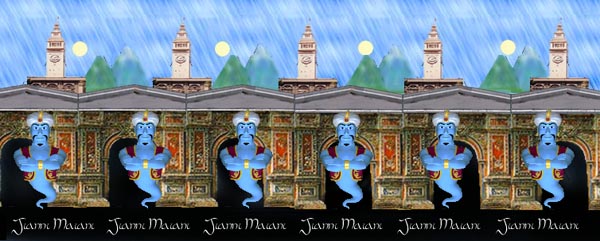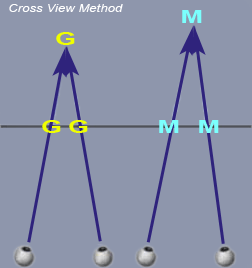SITS Examples
- FAQ About SIS
- SITS Examples
SITS (Single Image Text Stereogram) - EXAMPLES
Example n.1 - build a SITS using your name.
If you look at the example here below using the relaxed eye method, you will see the name "Gianni" (oh yes, it's me!) popping out from the monitor, while "Maiani" (still me!) should fall in a deeper plane "inside" the monitor. Viewing the same SITS with the crossed viewing method, the result is just the opposite.
Gianni Gianni Gianni Gianni Gianni Gianni Gianni Gianni Gianni Gianni
Maiani Maiani Maiani Maiani Maiani Maiani Maiani Maiani Maiani
Gianni Gianni Gianni Gianni Gianni Gianni Gianni Gianni Gianni Gianni
Maiani Maiani Maiani Maiani Maiani Maiani Maiani Maiani Maiani
Gianni Gianni Gianni Gianni Gianni Gianni Gianni Gianni Gianni Gianni
Maiani Maiani Maiani Maiani Maiani Maiani Maiani Maiani Maiani
Gianni Gianni Gianni Gianni Gianni Gianni Gianni Gianni Gianni Gianni
Maiani Maiani Maiani Maiani Maiani Maiani Maiani Maiani Maiani
|
|
What is going on? When eyes assume a relaxed position they focus a point that is located deeper than the plane where the words are materially located (the screen in this case). The process of focusing an imaginary plane during the observation of a SIS may be not so easy at the beginning. We already know that is due to the natural tendency of the eyes to converge on the surface of the objects. The repetition of a texture (which in SITS is represented by group of characters) is the key in allowing eyes to override their natural instinct. If you observe carefully the above sample, you'll notice that the distance between 2 consecutive "Gianni" is slightly different from the one that separates 2 consecutive "Maiani". The image on the left is almost self-explanatory and shows why the 2 names end to fall onto two imaginary planes positioned at different depths. |
Example n.2 - use any text editor to build as many SITS as your want.
In the example below, they were defined 5 different layers.
|
O /\ | O /\ | O /\ | O /\ |
/ \ /\/ \ / \ /\/ \ / \ /\/ \ / \ /\/ \/ \
__|O|__/ \ \__|O|__ / \ \_|O|__ / \ _\|O|__ / \ __|O|__
-/__|A|__\______/__|A|__\______/__|A|__\______/__|A|__\______/__|A|__\
XXXX--oooo--XXXXX--oooo--XXXXX--oooo--XXXXX--oooo--XXXXX--oooo--XXX
---XXX-oo-XXX---XXX-oo-XXX---XXX-oo-XXX---XXX-oo-XXX---XXX-oo-XXX---XX
OXX--XX O XX--XX O XX--XX O XX--XX O XX--XX O
/T\ XX /T\ XX /T\ XX /T\ XX /T\ XX /T\
/ | \XX / | \ XX / | \ XX / | \ XX / | \ XX / | \
/ \ XX / \ XX / \ XX / \ XX / \ XX / \
/ \XX / \ XX / \ XX / \ XX / \ XX /
\
Example n.3 - ready for something more complex?


